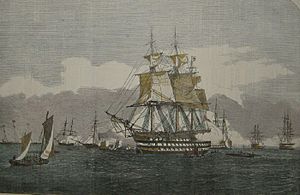HMS Neptune (1832) facts for kids

Neptune portrayed in the Illustrated London News, 1854
|
|
Quick facts for kids History |
|
|---|---|
| Name | HMS Neptune |
| Namesake | Neptune |
| Builder | Portsmouth Dockyard |
| Laid down | January 1827 |
| Launched | 22 September 1832 |
| Fate | Sold, 1875 |
| General characteristics | |
| Class and type | Broadened Caledonia-class ship of the line |
| Tons burthen | 2694 bm |
| Length | 205 ft 5.5 in (62.624 m) (gundeck) |
| Beam | 54 ft 6 in (16.61 m) |
| Depth of hold | 23 ft 2 in (7.06 m) |
| Propulsion | Sail |
| Sail plan | full-rigged ship |
| Armament |
|
HMS Neptune was a very large warship built for the Royal Navy (the British navy). She was known as a "first-rate ship of the line." This meant she was one of the biggest and most powerful warships of her time.
She was launched on September 22, 1832, at Portsmouth Dockyard in England. Neptune was originally powered only by sails. Later, she was updated with a new type of engine.
Contents
What Was a Ship of the Line?
Giants of the Sea
A "ship of the line" was a huge warship used from the 17th to the mid-19th century. These ships were the main fighting vessels of navies. They were designed to form a "line of battle" during sea fights. This allowed them to fire all their cannons at enemy ships.
Neptune was a "first-rate" ship. This meant she carried the most guns, usually 100 or more. She had 120 guns spread across her decks. These powerful ships were the battleships of their era.
Building a Mighty Ship
Building a ship like Neptune took many years. Her construction began in January 1827. It took over five years until she was launched in 1832. Shipyards like Portsmouth Dockyard were busy places. Skilled workers built these massive wooden vessels.
The ship was made mostly of wood. Strong oak was used for the hull. It had to be tough enough to withstand cannon fire.
Life on Board a Ship of the Line
A Floating City
A ship like Neptune was like a small, floating town. It had hundreds of sailors and marines living and working on board. They lived in crowded conditions. Life at sea was very tough.
Sailors had many duties. They had to manage the sails and rigging. They also had to keep the ship clean and ready for battle. Training for battle was a regular part of their lives.
The Ship's Armament
Neptune carried a huge number of cannons. These guns were placed on different decks.
- The lowest deck (gundeck) had 30 large 32-pounder cannons. It also had two very powerful 68-pounder carronades.
- The middle deck had 34 more 32-pounder cannons.
- The upper deck also had 34 32-pounder cannons.
- Smaller guns were on the quarterdeck and forecastle. These included 18-pounders and 32-pounder carronades.
These cannons fired heavy iron balls. They were designed to smash enemy ships.
The Age of Steam Power
A Big Change for Neptune
Originally, Neptune relied only on wind power. But by the mid-1800s, steam engines were becoming common. In 1859, Neptune was updated. She was fitted with "screw propulsion."
This meant a large propeller was added to the back of the ship. It was turned by a steam engine. This allowed the ship to move even when there was no wind. It also made her faster and more reliable.
The End of an Era
Adding screw propulsion was a big step forward. It showed how naval technology was changing. Ships like Neptune were powerful, but they were becoming outdated. Newer, iron-clad ships were being developed.
Neptune served the Royal Navy for many years. She was eventually sold out of service in 1875. This marked the end of her long career.

